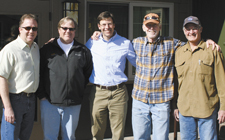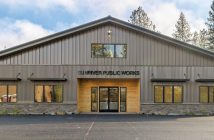
La Pine’s Little Deschutes Lodge Phase II Hits New Sustainable Heights
A groundbreaking senior affordable housing project exemplifying sustainability excellence has hit new green heights with the completion of Phase II of the Little Deschutes Lodge in La Pine, which has refined the energy-efficient envelope of its sister project opened on the same site to considerable acclaim some three years ago.
The recently unveiled two-story 26,000 square foot 26-unit independent living community building is something of a mirror image of the similar sized Phase I property, with a few new twists learned from best practices in the interim, and has enjoyed similar success from the outset, with a full slate of tenants on board within two weeks of opening.
Building on the success of its earlier counterpart, the latest project by Pacific Crest Affordable Housing – led by developers John Gilbert and Rob Roy – has illustrated the overwhelming demand for such accommodation from 55-and-over residents meeting up to 60 percent of local median income threshold requirements. The project team was rounded out by general contractor SunWest Builders and a host of adept subcontractors, with design services provided by BLRB Architects.
Amenities at Little Deschutes Lodge II include a community room gathering place complete with fireplace, audio visual hook-ups and warming kitchen, an exercise room, two laundry rooms and reading/recreation room, together with computer areas offering internet access, and an extended exterior patio with a fire pit.
A total of 22 one-bedroom, and four two-bedroom well-appointed units, with ADA adaptability, range in size from 690 to 900 square feet, each featuring its own patio or balcony, additional storage space, secure access and elevator service.
The complex is conveniently located next door to La Pine’s Senior Center, completing a triumvirate of complementary buildings creating an expansive lodge-style campus feel, and in walking distance of medical services, public transit, restaurants, retail shops, post office and the library.
The project is also a near net zero energy building, using an innovative geothermal mechanical system – supplying hot water to a centralized boiler and distribution system – laid out by Custom Plus Heating & A/C Inc. of Redmond, and a 32.2kW photo-voltaic and solar-thermal system installed by Bend’s E2 Solar, which neatly frame the carports.
The geothermal heating and cooling system features a grid of trenches on the site with some four miles of looped pipes that extracts underground heat and coordinates with the building’s exhaust/heat recovery ventilation Variable Refrigerant Flow (VRF) system to substantially reduce the building’s overall heating and cooling costs.
A wealth of other green features include a grey-water reuse system, harvesting rainwater for non-potable use and perimeter walls of Insulating Concrete Forms (ICF) construction, with thermal breaks utilized throughout to maximize insulative qualities.
Subsequent development is earmarked to include a “living machine” system, which uses living plants and beneficial microorganisms to treat wastewater and generate clean water for irrigation and toilet flushing, additional greenhouses, and landscaping including created wetlands incorporated in a “permaculture” ecological design drawn up with the aid of experts from Oregon State University.
As well as employing best practices, the green theme also has a real pragmatic thrust, as Roy explained, “Sustainability is an important driver of this project as the keys to longevity are to keep control of operating costs.
“One of the things that can jeopardize affordable housing ventures like this is that while rents have to be restricted for 60 years, operating costs can increase more than rents are able to, so a major motivation is to cover each energy-efficient base – including being creative in identifying every such source and incentive – as a hedge against rising utility costs for the long term.”
Gilbert added, “We strive to provide a safe and comfortable place for seniors to live independently and with dignity. Our residents also have peace of mind regarding financial security in knowing that rents won’t just go up according to the whims of the marketplace, which is especially relevant when you are on a fixed income and budget.
“Also, we set aside forty percent of the units for those defined under state guidelines as homeless and have filled them all rapidly, and it is great to see how people really appreciate the opportunity and thrive in this environment.”
The project was constructed on county-donated land and funded through a mix of government financing, tax credits and public financing.
Roy added, “Projects like this are obviously fundamentally driven by funding and Oregon Housing is well run and takes a balanced practical view, with collaboration between agencies and realization that housing can be a catalyst for many other good things in terms of leverages from linkages.
“In looking at Deschutes County, La Pine demonstrated a real need and we were delighted to play our part in meeting that demand.”
Project Architect Jim Landin of BLRB said, “We found out about the green light for funding in March 2012, so there has been a one year window to finish design and build, which was quite a feat for the whole team. We did have something of a full-scale mock-up across the way which was somewhat helpful!
“But the project morphed through changing orientations as well as taking some of the things we have learned through the process and incorporating other ideas to run with.
“We also continued the embodiment of the welcoming, comfortable tradition of great rustic Pacific Northwest lodges within budget constraints, including utilizing exposed wood beams and locally sourced repurposed timbers for several of the project’s finishes, evoking that familiar and timeless feel, which will be complemented by the addition of outdoor-themed artwork.”
Roy said that a few of the energy-efficient elements that were refined in the new project compared with Phase I included more advanced lighting controls using both vacancy and occupancy-related sensors and an “astronomical timer,” and wide use of sola tubes on the upper floor to maximize natural daylight, as well as incorporating an ingenious LED light and butterfly valve system for dusk to dawn hours which were created specially for the facility.
Much attention was also paid to mitigating heat loss which can occur when materials like metal penetrate the building envelope, with “thermal breaks” utilized wherever possible joining interior and exterior pieces such as wall or window assemblies with a less conductive material which reduces temperature transfer, even around nails.
Roy added that another way to give back to the community was via education, especially considering the dimension of public funding and the priority of efficiency in using such funds, in terms of being open with the creative sustainable technology utilized, which could also help act as a template for other projects.
Gilbert said that spacious interior hallways and other subtle opportunities for social interaction were designed into the project to help counteract the isolation that seniors often report feeling, adding, “Research has indicated that if older people stay socially active, it can help them stay healthier and we want people to be able to age with independence and dignity.
“Events are continually being organized, and there is a sense of unity between the buildings, including the Senior Center, which is really positive, and the feedback has been great.”
Little Deschutes Lodge is managed by Cascade Management, Inc. For more information, see website: www.cascade-management.com or 503-682-7788.
Little Deschutes Lodge 2
Property Owner/Developer: Pacific Crest Affordable Housing
Contractor: SunWest Builders
Project Cost: $3.4 million
Square Footage: 27,000
Project Manager: Wayne Powderly LEED AP, HCC, SunWest Builders
Superintendent: Mark Leavitt, SunWest Builders
Architect: BLRB Architects
Principal Architect: Jim Landin
Structural Engineer: Eclipse Engineering
Civil Engineer: Sun Country
Mechanical Engineer: Solarc
Subcontractors and Suppliers:
Cleaning Unlimited, Vic Russell Construction, Western Protective Coatings, Bend Concrete, Ultra Quiet Floors, Sather Masonry, Sunburst Fabrications, Buehner Construction, Miller Lumber, Truss Components, Dimar Siding, Coopers Carpentry, Patricks Woodworks, Bev-Art, JB Insulation, Am-1 Roofing, McKenzie Waterproofing, Commercial Door & Hardware, Cooper Custom Carpentry, Bend Commercial Glass, Solar Light, Premier Construction, Cascade Painting, Varner, TCS, NCBS, US Mailboxes, Fireside, Johnson Bros, NW Laundry Supply, Custom Tint, Thyssen, Bend Plumbing & Heating, Custom Plus Heating, Bend Fire Protection, Bend Electric, Apex Telecom




